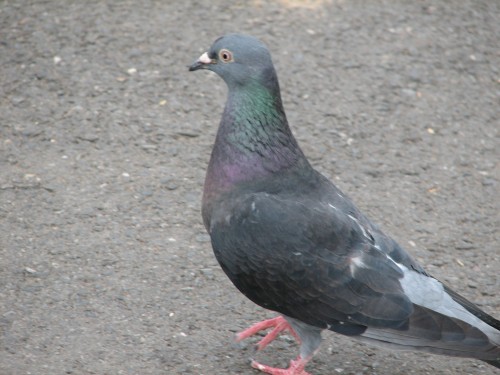Rock Dove
I don’t normally pay much attention to photographing introduced species, but this Rock Dove strutting around in the grounds of Adelaide Zoo caught my eye. It was almost right under my feet, the camera was ready to shoot and the bird was posing appropriately, so I took the photo.
Rock Doves, also called Feral Pigeons, are common throughout Australian cities and towns. They are especially common here in South Australia around cereal grain handling facilities, even in remote rural areas. The free grain available in such places provides a sustainable source of food. When I travelled overseas I discovered that they are very common in most places.
This individual, one of many, was feeding on food dropped by people visiting the zoo. The outdoor restaurant area was only a few metres behind me when I took the shot.
Rose-crowned Fruit-dove
On a recent visit to Adelaide Zoo, I focussed particularly on bird species. This zoo has an excellent collection of Australian birds plus a few exotics.
I managed this one photo of a Rose-crowned Fruit-dove, a species I have yet to see in the natural state. Sorry that the photo is slightly blurred – it was taken through the wire netting of the aviary.
Australia has six species in the family known as fruit-doves. Their diet is predominantly fruit, of course. This colourful species can be found in the northern extremes of Western Australia and the Northern Territory and from Cape York in Queensland down the eastern coast to about the Sydney region, sometimes even further south.
Dusky Turtle Dove, Ethiopia
The Dusky Turtle Dove (Streptopelia lugens) was a challenging bird for me to photograph during my visit to Ethiopia last December. Although they were relatively common on the school campus where my daughter was teaching, during our 2 week stay this species was almost reclusive in nature. One evening I stealthily chased one around the playground trying to get a photo. It was almost dark and the flash needed to be employed, but the bird keep moving around quickly and generally just out of effective reach of the flash.
On another occasion one bird was feeding in the car park right out in the open. Again it was in poor light and the bird keep moving around rapidly, to quickly to get the camera focussed on it. All those shots were blurred. In the end, I only managed to get 2 photos reasonable enough to show here. That’s nature photography I guess. You win some, you lose some – and the rest are just plain challenging.
Doing a little research on this species I have found little in the way of information online. It appears that both males and females of this species, along with closely related species, are able to produce “crop milk”, a soft lumpy substance resembling cheese. When it is fed to the young it nourishes them with its high protein content. Read more about it here.
Speckled Pigeon, Addis Ababa, Ethiopia
One of the colourful birds I saw on my visit to Addis Ababa, Ethiopia, last December was the very common Speckled Pigeon (Columba guinea) shown in the photos on this post. It was one of the more common birds in the grounds of the school where my daughter was teaching. The loud cooing of this species continued throughout most of the day.
This species is common throughout much of Africa south of the Sahara. It is common not only in urban areas like where I saw it, but also in farming areas, grasslands and open country. It is found from sea level through to land about 3000 metres in altitude.
Crested Pigeon close up
We love having the Crested Pigeons in our garden and on our two hectare (5 acre) block. They are a resident breeding species here and we see them every day. I’ve never really done a census count on how many there are around here, but we always seem to have at least a a half dozen or more. On a few occasions I have counted up to about 40 perching on the power lines running along the road side.
Crested Pigeons make a flimsy nest of a few sticks and it always surprises me how the eggs can possibly stay in the nest. An even greater mystery is how the chicks remain in the nest. They must be able to cope because they are very successful birds, breeding frequently.
Our local resident pigeons regularly visit our bird baths. This gives me many opportunities to do photographic studies of this species. Yesterday the bird in this set of photos posed nicely for me, first in the shade (see below) and then closer to me in the sunlight.








